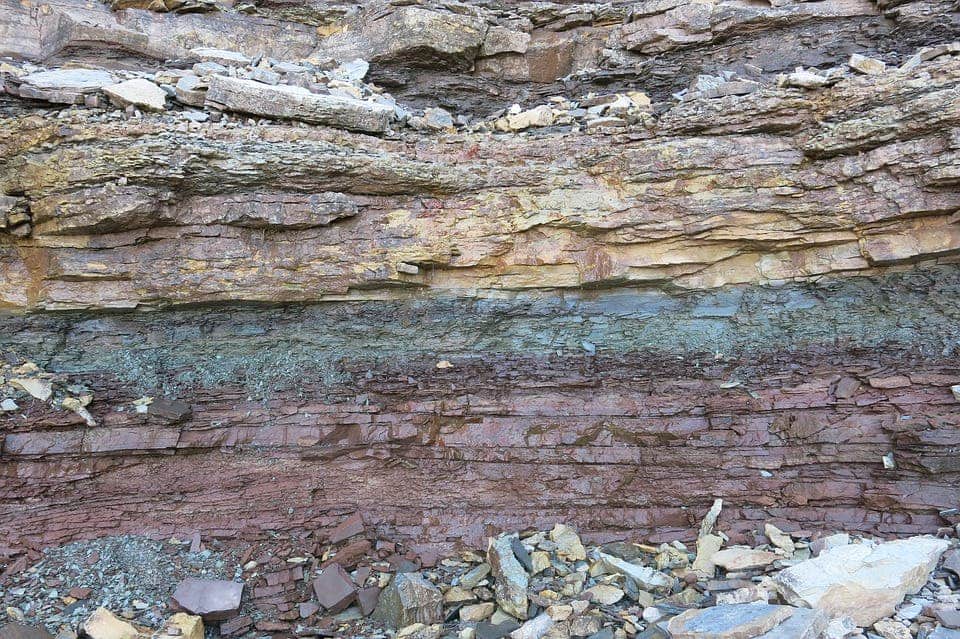To this day, the Cape Ann 1755 earthquake remains the largest earthquake in the history of Massachusetts. According to existing data, no one was killed, but it damaged hundreds of buildings in Boston and was felt as far north as Nova Scotia and as far south as South Carolina. Now, seismologists have found evidence for this earthquake in the unlikeliest of places: a pond.

A layer of sediment told researchers quite a bit about an old earthquake. Image in public domain, not from actual study.
Katrin Monecke of Wellesley College and her colleagues were able to identify a layer of light brown organic-rich mud within the core, deposited between 1740 and 1810. They concluded that the unusual sediment comes from an underwater landslide, probably caused by the Cape Ann earthquake.
Earthquakes are not common in New England, which lies on the inside of a tectonic plate. Earthquakes are much more common in places like California, which lie at the edge of tectonic plates. With few geological faults or other telltale clues of the earthquake, seismologists have gotten a bit more creative in their search for evidence.
“We don’t have any evidence of the fault that ruptured in 1755 for several reasons: the earthquake was probably not large enough to cause a surface rupture. Also, based on historical description of damage, the epicenter of the 1755 earthquake was most likely offshore,” Monecke told ZME Science in an email.
“It is important to see what an earthquake signature looks like in these sediments, so that we can start looking at deeper, older records in the region and then figure out whether 1755-type earthquakes take place for example, every 1000 years, or every 2000 years,” she added.
Earthquake forensics
Sluice Pond was in the area most strongly hit by the earthquake, which is why it was selected. Earthquakes need to be quite strong to be able to see deformation within the lake sediment. It has steep sides that would make it more susceptible to a landslide, and it has deep undisturbed layers of sediment for coring. Land clearing by settlers may have made the lake more susceptible to shaking.
“These were our main indicators that something had happened in the lake. We saw these near shore sediments and fragments of near-shore vegetation that appear to have been washed into the deep basin [by strong shaking],” said Monecke.
“It is important to see what an earthquake signature looks like in these sediments, so that we can start looking at deeper, older records in the region and then figure out whether 1755-type earthquakes take place for example, every 1000 years, or every 2000 years,” Monecke added.
The results could help to calculate the age of sediments from other ponds. You can learn more about the variation in the sediments and what they mean by also being able to know approximately when they happen. It would be interesting to look at the effect of earthquakes on the land in other areas. Researchers want to use these results as a sort of calibration and find older horizons in sediments for other earthquakes.
“This study can be seen as the calibration of earthquake-induced deformation in lake sediments in this area. With this information, we can now target deeper sediments that accumulated in Sluice Pond since the glaciers left the area and date back to about 16,000 years ago. Finding older earthquake horizons within these sediments will allow us to determine the recurrence intervals of 1755-type earthquakes. We also look at other lakes in the area, for example Walden Pond. It is the deepest lake in eastern Massachusetts and we expect to find an excellent sedimentary record here, too,” Monecke added in an email.
Although intraplate earthquakes are much rarer, they still do happen. Although they’re much rarer, they can still be quite massive.
“Earthquakes can occur in intraplate tectonic settings where strain is accumulating but at much slower rates compared to plate boundaries. This slow accumulation of strain causes large earthquakes to occur but with much longer recurrence intervals in the order of centuries to millennia. It is possible that preexisting, ancient fault lines get re-activated during these earthquakes,” Monecke concludes.
“The 1755 Cape Ann earthquake recorded in lake sediments of eastern New England –an interdisciplinary paleoseismic approach,” by Katrin Monecke et al, was published in Seismological Research Letters.









